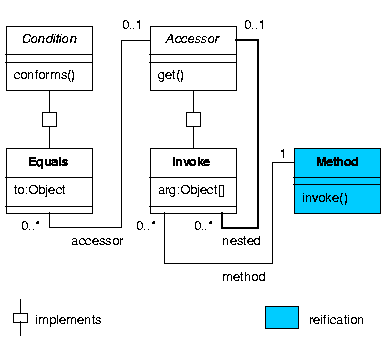



Next: Subscription Patterns
Up: Conditions
Previous: Basic conditions
JAVA inherently defines three basic comparison mechanisms,
which can be considered as candidates for B:
- 1.
- Is object o1 identical to object o2?
The comparison of two objects with the == operator yields
true iff the two arguments are references to the same object.
This comparison is less useful in our context, since two compared objects
usually originate from different VMs. By default two such objects
are never identical.
- 2.
- Is object o1 equal to object o2?
Every object can also be compared to any other object by means of the equals() method, which
is inherent to all JAVA objects and can be overwritten
by application-defined classes.
- 3.
- How does object o1 compare to object o2?
This is for objects implementing the java.lang.Comparable
interface,![[*]](foot_motif.gif) providing a method compareTo(). The return value
is an integer, indicating the order of the object o1 with respect
to o2. Such objects manifest a natural ordering, e.g., class
java.lang.Integer, and can thus be matched against a range
of values. Comparisons can be moved out of the
compared objects by using java.util.Comparator objects, which are
binary predicates.
providing a method compareTo(). The return value
is an integer, indicating the order of the object o1 with respect
to o2. Such objects manifest a natural ordering, e.g., class
java.lang.Integer, and can thus be matched against a range
of values. Comparisons can be moved out of the
compared objects by using java.util.Comparator objects, which are
binary predicates.
In general, B is represented in JAVA by a method, and can
also be viewed as Mk+1. Inversely, methods
Mj...Mk (j >= 1) can be seen as part of the comparison. In
that sense, we provide several shortcuts for common methods, e.g., to
compare the type of an object to a predefined one. This reflects the
method isInstance() (the dynamic counterpart to the instanceof
operator) in java.lang.Class.
In our condition classes, like the Equals class given in
Figure 8 (representing an equality test in the sense
of II), we have added constructors which alleviate their use. The third constructor
in the figure for instance enables the expression of nested method
calls by providing a URL-like string denoting the names of the
methods. The accessor is
in that case created implicitly. Figure 9 shows the links between our
JAVA implementation of accessors and conditions, illustrated through
the Equals and Invoke classes.
public final class Equals
implements Condition, java.io.Serializable
{
/* compare the message object as a whole */
public Equals(Object to) {...}
/* compare return value of accessor */
public Equals(Accessor acc, Object to) {...}
/* implicit accessor creation */
public Equals(String names, Object[][] args,
Object to) {...}
...
public boolean conforms(Object m) {...}
}
Figure 8: Equals Class (Excerpt)

Figure 9: Class Diagram



Next: Subscription Patterns
Up: Conditions
Previous: Basic conditions
Patrick Eugster
12/10/2000
![[*]](foot_motif.gif) providing a method compareTo(). The return value
is an integer, indicating the order of the object o1 with respect
to o2. Such objects manifest a natural ordering, e.g., class
java.lang.Integer, and can thus be matched against a range
of values. Comparisons can be moved out of the
compared objects by using java.util.Comparator objects, which are
binary predicates.
providing a method compareTo(). The return value
is an integer, indicating the order of the object o1 with respect
to o2. Such objects manifest a natural ordering, e.g., class
java.lang.Integer, and can thus be matched against a range
of values. Comparisons can be moved out of the
compared objects by using java.util.Comparator objects, which are
binary predicates.

